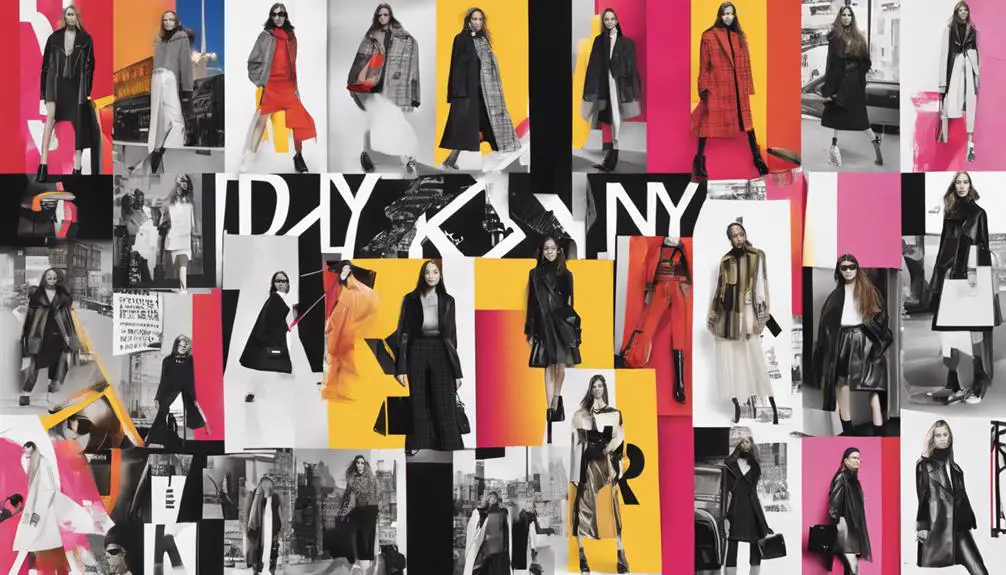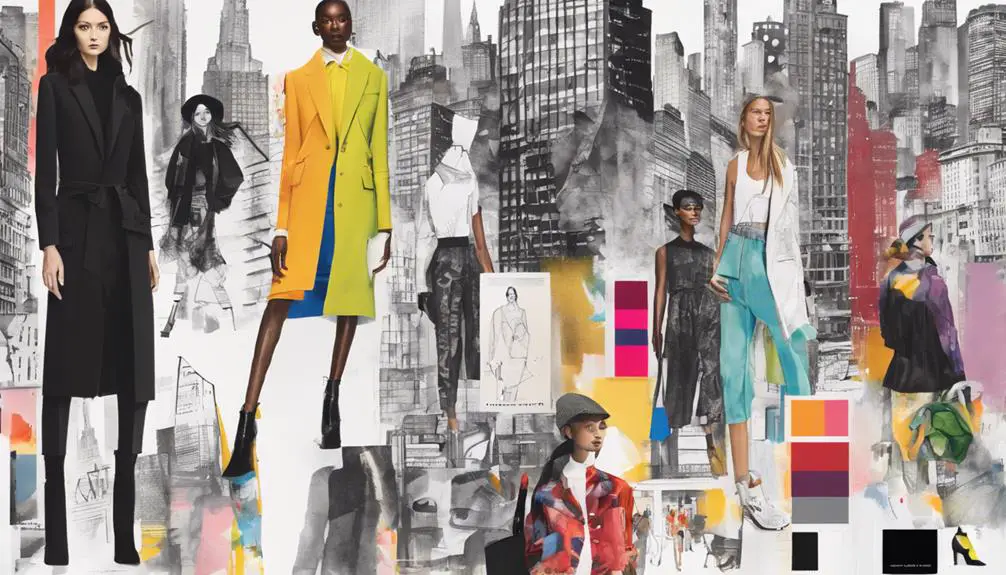When you think about the House of DKNY, you think about innovation, collaboration, and evolution. With a legacy built on partnerships that challenge norms and elevate urban culture, DKNY's designer collaborations have shaped the brand's identity considerably. But what happens when emerging talents enter the mix, and how do they influence the established vision? The interplay between iconic designers and fresh perspectives might reveal more about DKNY's future than you expect.
History of DKNY

When you think about contemporary fashion, DKNY often comes to mind as a vibrant representation of urban style. Founded in 1989 by the visionary fashion designer Donna Karan, DKNY started as a diffusion line aimed at a younger audience, drawing inspiration from her daughter, Gaby. The brand's debut collection showcased a range of urban-inspired apparel, perfectly reflecting the fast-paced lifestyle of New York City. This innovative approach quickly captured the attention of fashion enthusiasts, establishing DKNY as a key player in the industry. Its impact is akin to that of vintage Adidas, which has similarly resonated with diverse urban cultures over the decades.
Over the years, DKNY expanded its product range to include multiple sub-brands, such as DKNY Jeans and DKNY Active, each catering to different aspects of modern living. By Spring/Summer 2014, the brand celebrated its 25th anniversary, marking a significant milestone as it evolved into a lifestyle brand that resonates with diverse consumers. This transformation highlighted the brand's ability to adapt and thrive in a competitive market.
In 2016, a major shift occurred when LVMH sold the Donna Karan house, including DKNY, to G-III Apparel Group for an impressive $650 million. This acquisition allowed G-III to refocus their efforts on the DKNY brand, particularly for American buyers, ensuring its relevance in the ever-evolving fashion landscape.
DKNY's rich history and commitment to urban-inspired design continue to inspire fashion lovers, making it a staple in contemporary wardrobes.
Donna Karan's Design Philosophy
Donna Karan's design philosophy is rooted in the idea of creating versatile and easy-to-wear clothing that meets the needs of the modern woman. You'll find that her approach emphasizes functional fashion, allowing you to effortlessly shift from day to night.
One of Karan's standout innovations is her use of jersey draping, which not only enhances the fluidity of her designs but also complements the female form beautifully. This focus on adaptability mirrors the timeless appeal of classic brands like Ralph Lauren, which also prioritize quality and wearability in their offerings, particularly in their vintage pieces that showcase unique characteristics from different decades identifying vintage Ralph Lauren.
Karan's concept of a capsule wardrobe is revolutionary, integrating multiple pieces that can be mixed and matched for a cohesive look. Her Essentials line, launched with just seven key items, encourages you to simplify your wardrobe while still feeling stylish and put-together. Each piece is crafted from luxurious materials, guaranteeing that comfort and elegance go hand in hand.
What truly sets Donna Karan apart is her unwavering commitment to a womanly sensibility. She understands that modern clothes shouldn't just look good but also feel good. You can expect her designs to prioritize adaptability, allowing you to express your individuality while maintaining a chic aesthetic.
Whether you're dressing for a busy workday or a casual evening out, Karan's philosophy guarantees you're always prepared. Her collections embody a balance of sophistication and ease, making it clear that fashion can be both functional and fabulous.
When you wear her designs, you're embracing a lifestyle that celebrates the dynamic nature of contemporary womanhood.
Brand Expansion and Milestones

Since its launch in 1989, DKNY has rapidly evolved from a diffusion line into a global fashion powerhouse, appealing to a diverse audience. Founded by the innovative Donna Karan, DKNY initially targeted younger consumers with its fresh and accessible designs, much like J.Crew's early catalog success that defined its identity.
The brand's pivotal moment came with the introduction of "Seven Easy Pieces," a groundbreaking concept that emphasized interchangeable items for versatile wardrobes, altering how people approached fashion. This innovative approach to clothing echoed the strategies used by brands like J.Crew, which also focused on expanding its product offerings and engaging consumers through various platforms, as seen in their commitment to style.
DKNY didn't stop there. In 1991, the brand expanded its offerings by launching a menswear collection, which broadened its appeal even further. This strategic move showcased DKNY's commitment to inclusivity in style and fashion.
The company went public in 1996, a bold step that increased its visibility in the fashion industry. In 2001, DKNY was acquired by LVMH, which greatly boosted its global expansion and brand recognition. Under LVMH's guidance, the brand continued to flourish, solidifying its presence in the competitive fashion market.
After Karan's departure in 2015, the Donna Karan brand shifted to G-III Apparel Group in 2016 for an impressive $650 million, marking a notable milestone in its evolution.
Today, DKNY encompasses multiple sub-brands, including DKNY Jeans and DKNY Active, ensuring its relevance in a rapidly changing fashion landscape. With each step, DKNY has remained committed to delivering stylish, functional clothing that resonates with consumers worldwide.
The journey of brand expansion and milestones is a reflection of its innovative spirit and enduring legacy in the fashion world.
Controversies and Challenges
While DKNY has enjoyed significant growth and success, it hasn't been without its share of controversies and challenges. In 2013, the brand faced backlash for the unauthorized use of Brandon Stanton's street photography, which sparked public criticism and led to an official apology, along with a $25,000 donation to the YMCA. This incident highlighted the importance of intellectual property in the fashion industry, reminding everyone that creativity must be respected.
The brand's evolution over the years parallels that of iconic labels like Calvin Klein, which has also navigated its own challenges and transformations, reflecting the vintage tag evolution in the fashion world.
After Donna Karan's departure in 2015, the landscape shifted dramatically. LVMH chose to shelve Donna Karan International, signaling a strong focus on the more commercially viable DKNY brand. The subsequent sale of the Donna Karan house to G-III Apparel Group for a surprising $650 million in 2016 further underlined the brand's transformation. Karan herself praised DKNY's quality post-sale, indicating a sense of optimism amid the change.
However, DKNY's journey isn't without its hurdles. The fashion industry faces market volatility that impacts brand sustainability, and DKNY's challenges reflect broader systemic issues that emerging designers encounter.
The rise and fall of notable designers, such as Zac Posen, emphasize how difficult it's to maintain a successful brand in this highly competitive landscape. As DKNY navigates these challenges, it continues to adapt and evolve, proving that resilience is key in the ever-changing world of fashion.
Notable Designers and Collaborations

Throughout its history, DKNY has embraced a dynamic approach to fashion by collaborating with a diverse array of notable designers and artists. Founded by Donna Karan in 1989, the brand has greatly influenced contemporary fashion with its innovative designs and modern aesthetics.
These collaborations not only showcase DKNY's versatility but also highlight the creativity that defines the brand. Additionally, the brand's focus on vintage tag characteristics guarantees that its heritage is preserved and celebrated through these partnerships.
Here are three notable collaborations that stand out:
- Collier Schorr: In the early 1990s, DKNY joined forces with renowned fashion photographer Collier Schorr, creating high-profile advertising campaigns that captured the essence of urban style and youth culture, resonating deeply with the audience.
- Emerging Designers: DKNY has a rich history of spotlighting emerging designers, providing them with a platform to showcase their talent alongside established names in the fashion industry. This initiative fosters fresh creativity and ideas within the brand.
- Urban Artists and Influencers: By partnering with urban artists and influencers, DKNY appeals to a younger audience, aligning its ethos with modern trends and lifestyles. These collaborations encapsulate the brand's focus on modernity and versatility, assuring its relevance in a rapidly evolving market.
In embracing these collaborations, DKNY continues to push the boundaries of fashion, celebrating creativity and innovation while remaining true to its roots under Donna Karan's visionary guidance.




